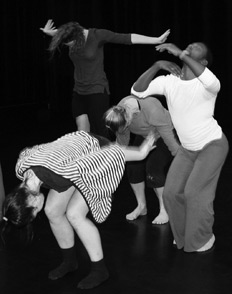Events
April 29, 2011
Choreographer constructs a concept of time

"The piece is constructed in sections and each section approaches time differently, and non-dance elements of the work provide different frames to perceive time," says Catellier.
The latest creation from Catellier Dance Projects, says choreographer Gregory Catellier, is about time. "It's about the difference between how humans experience time within a short lifetime and the realities of geological or evolutionary time."
"Tempo: A non-fiction dance performance" premieres in the dance studio of Emory's Schwartz Center for the Performing Arts on May 20-22. It is the product of a nine-month creation and rehearsal process.
Working with the six dancers of Catellier Dance Projects (Alex Abarca, Joel Taylor Ballard, Corian Ellsior, Ellen Lyle '09C, Lillian Ransijen '05C, and Chelsea Spencer '10C), Catellier constructed a single, evening-length dance piece with original music by Kendall Simpson and multimedia installation work by Seattle-based dancer and new media artist Jeffrey Curtis.
Catellier discusses the concept and creative process behind his latest work:
Nicholas Surbey: "Time" is certainly a large concept. How do you tackle that idea in a dance piece?
Gregory Catellier: The piece is constructed in sections and each section approaches time differently, and non-dance elements of the work provide different frames to perceive time. Music is slowed down, video is sped up, a voice-over explains metric time, a dancer tells you precisely how long the work is. The projected video of the dancers also provides a window into the not-too-distant past when we filmed the dance phrases. We see that Alex has grown a beard and that Chelsea has dyed her hair. By presenting so many facets of time, I hope the audience members will examine their own relationship to time.
NS: Are there elements of "time" that you think can best be expressed kinetically, that are most clearly represented and shared through dance?
GC: Until the advent of electronic digital technology, all timekeeping devices relied on the movement of something to keep time. That said, the body is a time piece. It keeps time by the beating of the heart, the swinging of the arms and the manifestations of age. Therefore dance is particularly well suited to express concepts having to do with time in that it is movement of the body.
NS: What is different about choreographing a single, evening-length dance piece as opposed to several smaller works, as is more usual?
GC: The biggest difference in the process has been the rehearsal time it takes. Knowing that the work would be evening-length and that I wanted to have the luxury to explore ideas in the studio made me construct an extended nine-month process. It has also allowed me to think in larger, more abstract terms.
NS: How has collaboration with your dancers shaped the projects?
GC: The collaboration runs deep. The dancers have contributed only a small number of dance actual dance phrases, but the ongoing conversation that we have had about the subject matter and the work itself has profoundly affected the work. When you get into the groove of a rehearsal, opportunities arise; I ask a question, a dancer makes a suggestion, we try it, one dancer may misunderstand the directive and do it wrong, but the results are beautiful.
